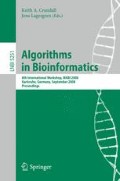Abstract
Inferring transcriptional regulatory networks from gene-expression data remains a challenging problem, in part because of the noisy nature of the data and the lack of strong network models. Time-series expression data have shown promise and recent work by Babu on the evolution of regulatory networks in E. coli and S. cerevisiae opened another avenue of investigation. In this paper we take the evolutionary approach one step further, by developing ML-based refinement algorithms that take advantage of established phylogenetic relationships among a group of related organisms and of a simple evolutionary model for regulatory networks to improve the inference of these networks for these organisms from expression data gathered under similar conditions.
We use simulations with different methods for generating gene-expression data, different phylogenies, and different evolutionary rates, and use different network inference algorithms, to study the performance of our algorithmic boosters. The results of simulations (including various tests to exclude confounding factors) demonstrate clear and significant improvements (in both specificity and sensitivity) on the performance of current inference algorithms. Thus gene-expression studies across a range of related organisms could yield significantly more accurate regulatory networks than single-organism studies.
Access this chapter
Tax calculation will be finalised at checkout
Purchases are for personal use only
Preview
Unable to display preview. Download preview PDF.
References
Akutsu, T., Miyano, S., Kuhara, S.: Identification of genetic networks from a small number of gene expression patterns under the Boolean network model. In: Proc. 4th Pacific Symp. on Biocomputing (PSB 1999), pp. 17–28. World Scientific, Singapore (1999)
Babu, M.M., Luscombe, N.M., Aravind, L., Gerstein, M., Teichmann, S.A.: Structure and evolution of transcriptional regulatory networks. Curr. Opinion in Struct. Bio. 14(3), 283–291 (2004)
Babu, M.M., Teichmann, S.A.: Evolution of transcription factors and the gene regulatory network in Escherichia coli. Nucleic Acids Res. 31(4), 1234–1244 (2003)
Babu, M.M., Teichmann, S.A., Aravind, L.: Evolutionary dynamics of prokaryotic transcriptional regulatory networks. J. Mol. Bio. 358(2), 614–633 (2006)
Bar-Joseph, Z.: Analyzing time series gene expression data. Bioinformatics 20(16), 2493–2503 (2004)
Bourque, G., Sankoff, D.: Improving gene network inference by comparing expression time-series across species, developmental stages or tissues. J. Bioinform. Comput. Biol. 2(4), 765–783 (2004)
Chen, T., He, H.L., Church, G.M.: Modeling gene expression with differential equations. In: Proc. 4th Pacific Symp. on Biocomputing (PSB 1999), pp. 29–40. World Scientific, Singapore (1999)
Conant, R.C.: Extended dependency analysis of large systems. Int’l J. General Systems 14(2), 97–141 (1988)
Friedman, N.: Inferring cellular networks using probabilistic graph models. Science 303(5659), 799–805 (2004)
Friedman, N., Linial, M., Nachman, I., Pe’er, D.: Using Bayesian networks to analyze expression data. J. Comput. Bio. 7(3-4), 601–620 (2000)
Friedman, N., Murphy, K.P., Russell, S.: Learning the structure of dynamic probabilistic networks. In: Proc. 14th Conf. on Uncertainty in Art. Intell. UAI 1998, pp. 139–147 (1998)
Hillis, D.M.: Approaches for assessing phylogenetic accuracy. Syst. Bio. 44, 3–16 (1995)
Kanehisa, M., Goto, S., Hattori, M., Aoki-Kinoshita, K.F., Itoh, M., Kawashima, S., Katayama, T., Araki, M., Hirakawa, M.: From genomics to chemical genomics: new developments in KEGG. Nucleic Acids Res. 34, D354–D357 (2006)
Kim, S.Y., Imoto, S., Miyano, S.: Inferring gene networks from time series microarray data using dynamic Bayesian networks. Briefings in Bioinformatics 4(3), 228–235 (2003)
Liang, S., Fuhrman, S., Somogyi, R.: REVEAL, a general reverse engineering algorithm for inference of genetic network architectures. In: Proc. 3rd Pacific Symp. on Biocomputing (PSB 1998), pp. 18–29. World Scientific, Singapore (1998)
Moret, B.M.E., Warnow, T.: Reconstructing optimal phylogenetic trees: A challenge in experimental algorithmics. In: Fleischer, R., Moret, B.M.E., Schmidt, E.M. (eds.) Experimental Algorithmics. LNCS, vol. 2547, pp. 163–180. Springer, Heidelberg (2002)
Murphy, K.P.: The Bayes net toolbox for MATLAB. Computing Sci. and Statistics 33, 331–351 (2001)
Pupko, T., Pe’er, I., Shamir, R., Graur, D.: A fast algorithm for joint reconstruction of ancestral amino acid sequences. Mol. Bio. Evol. 17(6), 890–896 (2000)
Slonim, D.K.: From patterns to pathways: gene expression data analysis comes of age. Nature Genetics 32, 502–508 (2002)
Teichmann, S.A., Babu, M.M.: Gene regulatory network growth by duplication. Nature Genetics 36(5), 492–496 (2004)
Wang, R., Wang, Y., Zhang, X., Chen, L.: Inferring transcriptional regulatory networks from high-throughput data. Bioinformatics 23(22), 3056–3064 (2007)
Xu, R., Hu, X., Wunsch, D.C.: Inference of genetic regulatory networks from time series gene expression data. In: Proc. IEEE Int’l Joint Conf. on Neural Networks, vol. 2, pp. 1215–1220. IEEE Press, Piscataway (2004)
Yu, J., Smith, V.A., Wang, P.P., Hartemink, A.J., Jarvis, E.D.: Advances to Bayesian network inference for generating causal networks from observational biological data. Bioinformatics 20(18), 3594–3603 (2004)
Zhao, W., Serpedin, E., Dougherty, E.R.: Inferring gene regulatory networks from time series data using the minimum length description principle. Bioinformatics 22(17), 2129–2135 (2006)
Author information
Authors and Affiliations
Editor information
Rights and permissions
Copyright information
© 2008 Springer-Verlag Berlin Heidelberg
About this paper
Cite this paper
Zhang, X., Moret, B.M.E. (2008). Boosting the Performance of Inference Algorithms for Transcriptional Regulatory Networks Using a Phylogenetic Approach. In: Crandall, K.A., Lagergren, J. (eds) Algorithms in Bioinformatics. WABI 2008. Lecture Notes in Computer Science(), vol 5251. Springer, Berlin, Heidelberg. https://doi.org/10.1007/978-3-540-87361-7_21
Download citation
DOI: https://doi.org/10.1007/978-3-540-87361-7_21
Publisher Name: Springer, Berlin, Heidelberg
Print ISBN: 978-3-540-87360-0
Online ISBN: 978-3-540-87361-7
eBook Packages: Computer ScienceComputer Science (R0)

